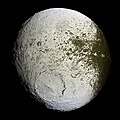Datei:Iapetus as seen by the Cassini probe - 20071008.jpg

Größe dieser Vorschau: 600 × 600 Pixel. Weitere Auflösungen: 240 × 240 Pixel | 480 × 480 Pixel | 768 × 768 Pixel | 1.024 × 1.024 Pixel | 2.048 × 2.048 Pixel | 4.032 × 4.032 Pixel
Originaldatei (4.032 × 4.032 Pixel, Dateigröße: 6,22 MB, MIME-Typ: image/jpeg)
Dateiversionen
Klicke auf einen Zeitpunkt, um diese Version zu laden.
| Version vom | Vorschaubild | Maße | Benutzer | Kommentar | |
|---|---|---|---|---|---|
| aktuell | 19:07, 12. Dez. 2018 |  | 4.032 × 4.032 (6,22 MB) | Kesäperuna | 100% JPEG quality from full quality TIFF, slightly cropped to be more centered. |
| 10:18, 9. Okt. 2007 |  | 4.100 × 4.100 (1,56 MB) | Startaq | {{Information |Description = Cassini captures the first high-resolution glimpse of the bright trailing hemisphere of Saturn's moon Iapetus. This false-color mosaic shows the entire hemisphere of Iapetus (1,468 kilometers, or 912 miles across) visible fro |
Dateiverwendung
Die folgenden 14 Seiten verwenden diese Datei:
- 1671
- Albedo
- Cassini-Huygens
- Einschlagkrater
- Gerin (Krater)
- Iapetus (Mond)
- Liste der besuchten Körper des Sonnensystems
- Liste der größten Objekte im Sonnensystem
- Ringe des Saturn
- Benutzer:BullBoxerBAB/Himmelskörper im Sonnensystem
- Wikipedia:Exzellente Bilder/Naturwissenschaften
- Wikipedia:Hauptseite/Archiv/25. Oktober 2021
- Wikipedia:Kandidaten für exzellente Bilder/Archiv2008/2
- Portal:Astronomie/Zufallsbild
Globale Dateiverwendung
Die nachfolgenden anderen Wikis verwenden diese Datei:
- Verwendung auf af.wiki.x.io
- Verwendung auf an.wiki.x.io
- Verwendung auf ar.wiki.x.io
- Verwendung auf ary.wiki.x.io
- Verwendung auf arz.wiki.x.io
- Verwendung auf ast.wiki.x.io
- Verwendung auf az.wiki.x.io
- Verwendung auf ba.wiki.x.io
- Verwendung auf be.wiki.x.io
- Verwendung auf bg.wiki.x.io
- Verwendung auf bn.wiki.x.io
- Verwendung auf bn.wikibooks.org
- Verwendung auf bs.wiki.x.io
- Verwendung auf ca.wiki.x.io
- Verwendung auf ckb.wiki.x.io
- Verwendung auf cs.wiki.x.io
- Verwendung auf cv.wiki.x.io
- Verwendung auf cy.wiki.x.io
- Verwendung auf de.wikinews.org
- Verwendung auf el.wiki.x.io
Weitere globale Verwendungen dieser Datei anschauen.



